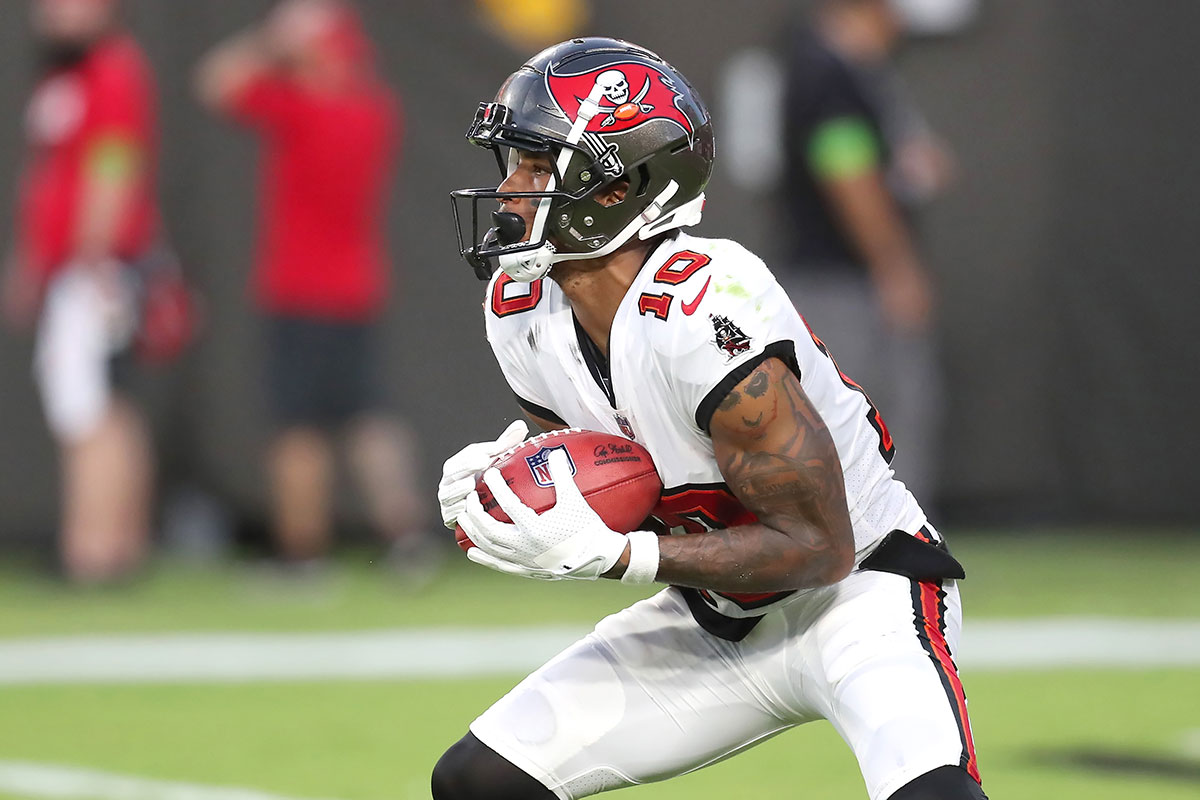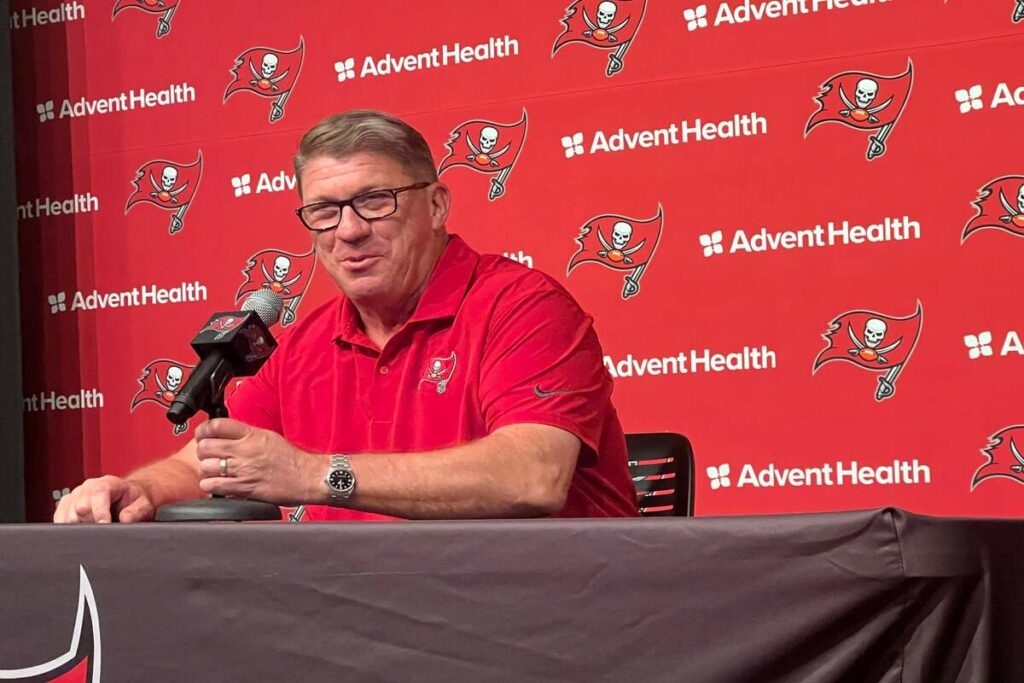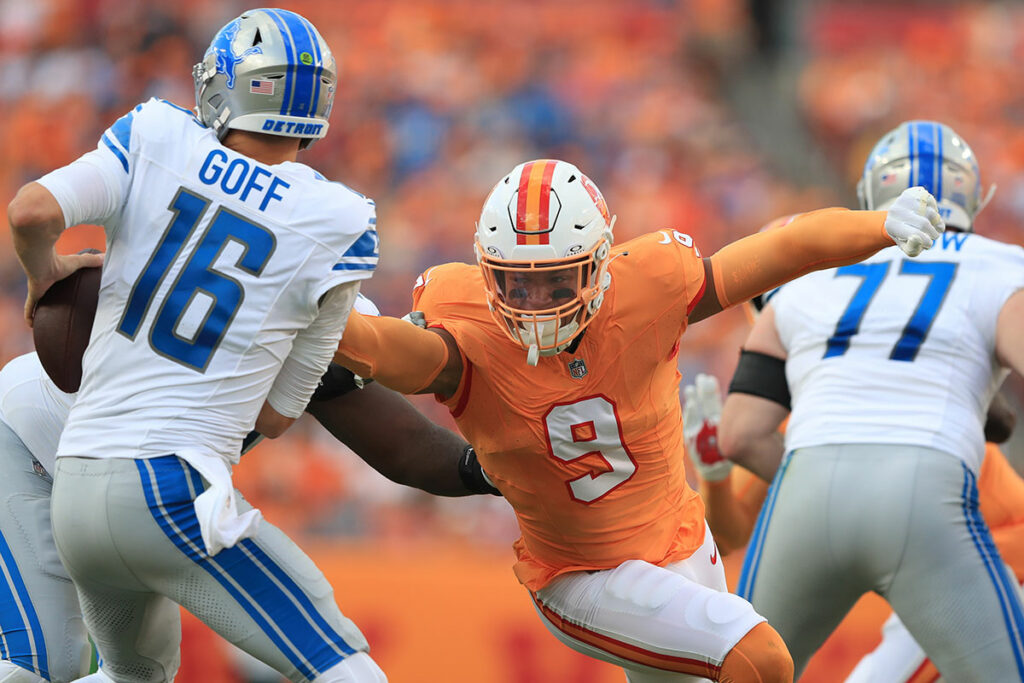The Bucs made a bit of a surprising move late last week when they cut third-year wide receiver/return man Deven Thompkins, waiving him with an injury designation.
After signing as an undrafted free agent out of Utah State in 2022, Thompkins contributed sparingly to Tampa Bay’s offense during his two seasons with the team. Where he was a mainstay, though, was on special teams. Now, no one will argue that Thompkins was an elite kick returner or punt returner, as he returned 31 punts for 295 yards (9.5 avg.) and returned 28 kicks for 590 yards (21.1 avg.) over two seasons with the Bucs. Those aren’t irreplaceable numbers by any means.

Bucs WR-KR-PR Deven Thompkins – Photo by: Cliff Welch/PR
So, with Thompkins gone, who might new special teams coordinator Thomas McGaughey and the coaches turn to? There are quite a few in-house candidates who could handle kick and punt return duties, and some early candidates may have emerged during OTAs last week. A few different players mixed in and got reps with Thompkins, though head coach Todd Bowles didn’t have a lot to say on the topic after practice.
“I don’t think anybody has showed me flashes in four days – they’re just catching punts right now,” Bowles said. “It won’t come, really, until training camp right now. Everybody is back there catching punts. Hell, I can compete right now because I can catch them if you kick them to me. We’ll wait for the summer and see how that develops.”
The competition for the vacant return man job may not really kick into high gear until training camp and the preseason, but that doesn’t mean we can’t take an early look at the resumes of some of Bucs’ in-house candidates. But first, it’s important to remember that Bowles, McGaughey and the Bucs will have to make their decision on Thompkins’ replacement while adjusting to the NFL’s new rules.
Bucs Will Have To Take New Kickoff Rules Into Consideration
Before we get into the possibilities to return kicks and punts for the Bucs, there’s also the matter of the NFL’s new kickoff rules, which were introduced this offseason. Borrowed from the XFL and installed to both encourage more returns and action while reducing the number of injuries, it’s going to be an adjustment for all 32 teams this season. It’ll also be an adjustment for the fans, as it’s a lot to understand and it’ll take some time to get used to it when it’s playing out on the field.
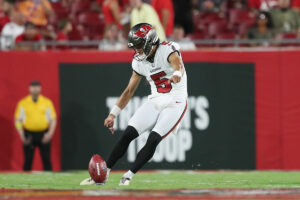
Bucs P Jake Camarda – Photo by: Cliff Welch/PR
Here are the rules, as NFL.com’s Kevin Patra explained them:
“The passed kickoff rule features new alignments for both the kicking and receiving units. A “landing zone,” the area between the receiving team’s goal line and its 20-yard line, would prompt action off the kickoff if the ball were to land in that sector.
Kickoffs will remain at the 35-yard line, but the remaining 10 players on the kicking unit will line up at the opposing team’s 40-yard line. The receiving team lines up with at least seven players in the “set-up zone,” a five-yard area between their own 35- and 30-yard lines, with a maximum of two returners can line up in the landing zone.
After the ball is kicked, the kicker cannot cross the 50-yard line and the 10 kicking team players cannot move until the ball hits the ground or a player in the landing zone or goes into the end zone. The receiving team’s players in the set-up zone also cannot move until the kick has hit the ground or a player in the landing zone or the end zone. The returner(s) may move at any time before or during the kickoff.”
Kicking off a new era: Owners just approved the NFL Hybrid Kickoff rule, per source.
After years of tweaks turned one of the game’s most exciting moments into a “dead, ceremonial play”, the league hopes this overhaul will yield what it wants: fewer injuries and more returns. pic.twitter.com/jHLAjZJm0z
— Tom Pelissero (@TomPelissero) March 26, 2024
Candidates For Bucs’ Kick Return And Punt Return Jobs
Other players could always emerge during the final week of OTAs, in mandatory mini-camp or even when the team comes back together for training camp. But for now, here’s a look at the players who were back to catch punts and kicks last week.
Trey Palmer
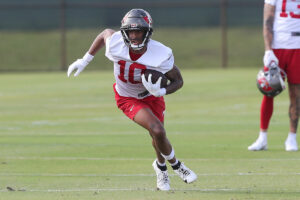
Bucs WR Trey Palmer – Photo by: Cliff Welch/PR
Palmer got some return reps as a rookie during training camp and the preseason last year, and it’s not hard to see why he’d be an intriguing option to replace Thompkins in 2024. The former Nebraska star ran a 4.33-second 40-yard dash at the NFL Scouting Combine last year and has elite speed, which he put on display on a few occasions last season.
It also helps that Palmer has some experience returning kicks and punts. In three years at LSU, he returned 15 kickoffs for 394 yards (26.3 avg.) and a touchdown while also returning 23 punts for 188 yards (8.1 avg.) and a touchdown. In his lone year at Nebraska, Palmer returned three kicks for 62 yards (20.7 avg.) and took four punts for 36 yards (9.0 avg.).
During the preseason last year, Palmer returned four kickoffs for 102 yards (25.5 avg.) in addition to returning two punts for 29 yards (14.5 avg.).
Rachaad White

Bucs RB Rachaad White – Photo by: Cliff Welch/PR
White has regular season kick return experience with the Bucs, albeit under the old rules. As a rookie in 2022, he returned 11 kicks for 244 yards (22.2 avg.) with a long of 30 yards. He did fumble on the opening kickoff of the team’s loss to the Chiefs that year. Tampa Bay’s starting running back had minimal experience on kick and punt returns at Arizona State, returning just three kicks for 47 yards (15.7 avg.) and four punts for 47 yards (11.8 avg.).
Although the new kickoff rules are designed to reduce injuries, the Bucs will no doubt have to seriously consider the risk of putting their No. 1 running back on kick return duties. His time as the team’s return man as a rookie came when he was in a backfield tandem with Leonard Fournette.
Now that White has blossomed into Tampa Bay’s go-to guy in the backfield and given that he is coming off of a 2023 season in which he ran 272 times and caught 64 passes (for a total of 336 touches), it’d be understandable if the team wasn’t too keen on sending him back to return kicks in 2024.
Jalen McMillan
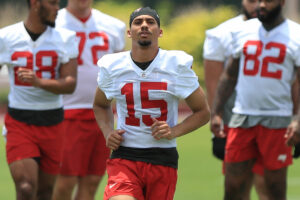
Bucs WR Jalen McMillan – Photo by: Cliff Welch/PR
McMillan, one of the Bucs’ third-round picks in the 2024 Draft, was another player who got some return reps during week two of OTAs. The former Washington standout ran a 4.47 in the 40-yard dash at this year’s NFL Scouting Combine, and it’s that speed that could get him some consideration in the return game.
McMillan didn’t return any kicks at Washington, though he did have minimal punt return reps. Between 2022 and 2023 with the Huskies, he returned nine punts for 83 yards (9.2 avg.). His longest punt return went for 31 yards in 2022, though that means if you eliminate the outlier, he returned the other eight punts for just 52 yards (6.5 avg.).
With the rookie wide receiver, the Bucs may have a similar hesitation as they might have with White. If McMillan is going to be the team’s WR3, that’s going to be a starting position most of the time in Liam Coen’s offense. Would Tampa Bay take any risks, especially with a guy who dealt with a knee issue during his final season at Washington? It’s worth wondering.
Bucky Irving

Bucs RB Bucky Irving – Photo by: Cliff Welch/PR
The final player taking reps with the kick return team last week was Irving, the Bucs’ fourth-round pick. The running back out of Oregon doesn’t have the same high-end speed as some of these other candidates, as he ran a 4.55-second 40-yard dash during the pre-draft process. Given his size, that was a bit of a disappointment. But his tackle-breaking ability is well documented and could serve him well with the new kick return rules.
Over the last three years (one at Minnesota, two at Oregon), Irving did get the opportunity to return some kicks. He returned nine for 194 yards (21.6 avg.) in 2021 at Minnesota, with a long of 41 yards. In his first season at Oregon in 2022, he returned five kicks for 123 yards (24.6 avg.) and a long of 37 yards. Then, last year, he returned just one kick for 17 yards.
Irving could find himself in a role similar to the one Rachaad White held as a rookie, where he mixes into the backfield to spell the starter while getting a chance to make an impact and get on the field on special teams. Would Irving’s size be a concern? Not necessarily, especially when you consider he’s bigger than 5-foot-8, 155-pound Deven Thompkins and Tampa Bay clearly wasn’t deterred by him being a more compact back during the draft process.
Bailey Adams is in his fourth year with Pewter Report. Born and raised in Tampa, he has closely followed the Bucs all his life and has covered them in some capacity since 2016. In addition to his responsibilities as a beat writer, he also contributes to the site as an editor. He graduated from the University of Central Florida in 2019 and currently co-hosts The Pegasus Podcast, a podcast dedicated to covering UCF Football.

